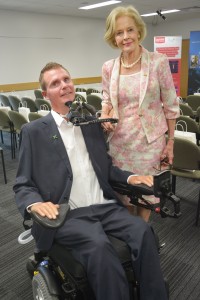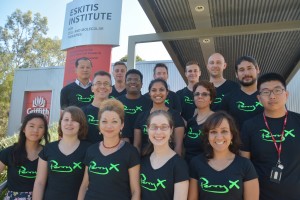Griffith University’s Eskitis Institute for Drug Discovery opened its door for a ‘Scientific Open House’ organised with the Perry Cross Spinal Research Foundation to thank their donors for their contributions to scientific research.
Part of the research at Eskitis aims to find a cure for spinal cord paralysis.
Former Governor-General The Honourable Dame Quentin Bryce AD CVO, Patron of the Perry Cross Spinal Research Foundation began supporting the cause after seeing first-hand the impact a spinal injury had on Perry Cross and his family.
“Perry was a regular 19 year old boy when a devastating rugby accident at Ballymore rendered him a C2 quadriplegic, unable to move from the neck down, and unable to breathe without a mechanical ventilator,” she said.
“Perry established the Perry Cross Spinal Research Foundation in 2010, to help make a cure for paralysis a reality.
“A cure for paralysis is absolutely possible. Ground breaking medical trials in Poland last year resulted in 38 year old year old quadriplegic man able to walk again.”
More than 12,000 Australians currently live with a spinal cord injury; with the most common causes being car accidents, falls and water related accidents.
Eskitis Project Leader Dr James St John and his research team were studying ways to grow cells that are more effective and survive better after transplantation into the spinal cord.
It is a process through which glial cells from the olfactory mucosa — located in the upper region of the nasal cavity — are relocated to the damaged spinal cord. Glial cells are the supporting cells of the nervous system and can help nerve fibres to regenerate.
“What we have also discovered is that the natural compound curcumin, which comes from the spice turmeric, can stimulate the cells that are used for transplantation into the spinal cord,” says Dr St John.
“What we now need to do is to make it more effective so it is stable and can be used in therapy for humans.
For more photos from the event see Griffith Facebook page.
The Eskitis team has recently had a paper published in the prestigious Nature group journal Scientific Reportswhich presents a novel technique to grow cells in three dimensions, without the traditional restrictions of matrix or scaffolds. Read more about this research here.


